| Shadows will cause livestock to balk. | 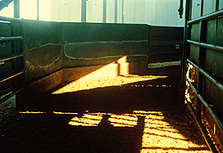 |
Professional Animal Scientist, December 1989 pages 1-11
published by: American Registry of Professional Animal
Scientists
TEMPLE GRANDIN
Livestock Handling Systems. Inc,
Animal Science Department
Colorado State University
Fort Collins, Colorado 80523
Reviewed by S.D. Musgrave and G.W. Thrasher.
Even though ruminant animals have depth perception, their ability to perceive depth at ground level while moving with their heads up is probably poor (59). Hutson (50) suggests that there may be an extensive blind area at ground level and moving livestock may not be able to use motion parallax or retinal disparity cues to perceive depth. To see depth on the ground, the animal would have to stop and lower its head. This may explain why livestock often lower their heads and stop to look at strange things on the ground. Cattle, pigs, sheep and horses will often balk and refuse to walk over a drain grate, hose, puddle, shadow or change in flooring surface or texture (22, 24, 62).
| Shadows will cause livestock to balk. |  |
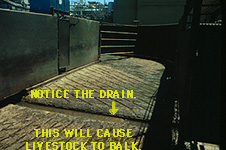 |
Drains should be located outside of the areas where animals walk. A drain or a metal plate running across an alley will cause balking. |
In areas where animals are handled, illumination should be uniform and diffuse. Shadows and bright spots should be minimized. Slats on the floor of shearing sheds and other animal facilities, should be eliminated so animals walk across the slats (48). Flapping objects or a coat hung on a chute fence may stop animal movement.
Pigs, sheep, and cattle have a tendency to move from a dimly illuminated area to a more brightly illuminated area, provided the light is not glaring in their eyes (22, 62, 90). A spot light directed onto a ramp or other apparatus will often facilitate entry. The light must not shine directly into the eyes of approaching animals. Recent research by Phillips et al., (74) indicated that pigs reared indoors preferred to walk up a ramp illuminated at 80 lux which was similar to the illumination of the rearing quarters. A dimly illuminated ramp with less than 5 lux was avoided. There was also a tendency to avoid an excessively bright ramp illuminated with 1200 lux.
Moving or flapping objects can also disrupt handling. Fan blades or a flapping cloth can cause balking. Animals may refuse to walk through a chute if they can see motion up ahead (31).
Livestock have color perception. Numerous investigators have now confirmed that cattle, pigs, sheep and goats all possess color vision (9, 10, 19, 40, 58, 68). Handling facilities should be painted one uniform color. All species of livestock are more likely to balk at a sudden change in color or texture.
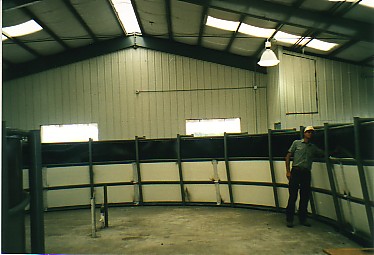
Well designed curved single file chute with solid sides to block the animal's vision. White translucent skylights provide good lighting with no shadows. The black strip along the top of the chute (race) is flexible rubber conveyor belting. The belting blocks the animal's vision and handlers can easily reach under the belting to move cattle.
Cattle have a natural tendency to want to see the handler. Some advocates of low stress handling recommend removing all the solid sides so the cattle can see the handler's position. I have observed in many places that the most important place to have solid sides is on the outer perimeter of a facility. This is especially important if there is any activity outside the fence such as moving vehicles or people walking by. When solid sides are removed, much greater skill is required to prevent the cattle from becoming agitated. In a chute (race) system whwere solid sides have been removed, ALL people must remain outside the animal's flight zone until it is time to enter the flight zone to move an animal. If a person continually stands inside the flight zone, cattle standing in a chute may become agitated and start scuffing their feet or rearing. After a person enters the flight zone to move an animal through the chute, they must immediately back up to remove themselves from the flight zone.
In existing facilities, you can experiment with adding or removing solid sides to determine what works best for you. It is important to used rigid materials that do not flap. Adding solid sides is especially recommended for the following:
 Click here to see more photos with tips to reduce balking and improve animal movement.
Click here to see more photos with tips to reduce balking and improve animal movement.
Livestock producers and researchers have learned from practical experience that continuous playing of a radio with a variety of talk and music will reduce the reaction of pigs to sudden noises. Providing controlled amounts of continuous but varying background sound may help prevent weight gain losses caused by unexpected noises.
In facilities where livestock are handled, loud or novel noises should be avoided because they distress livestock (31). It may be advisable to have the same radio station or background sound that is provided in the living quarters. Research is needed to determine if exposing animals to sounds such as truck noise would help reduce stress.
The sound of hanging metal can cause balking and agitation (31). Rubber stops on gates and squeeze chutes will help reduce noise (26). The pump and motor on a hydraulic squeeze chute should be located away from the squeeze. Exhausts on pneumatic powered equipment should be piped away from the handling area. Small amounts of noise can be used to move livestock. Cattle and sheep will move away from a rustling piece of plastic. If sheep become excited they will not respond to this stimulus (87).
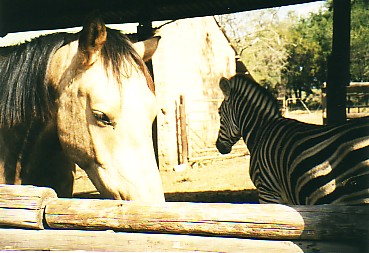
Horses, cattle, and other grazing animals will point their ears towards things that concern them. The zebra and the horse are both pointing an ear at each other. The horse has one ear pointed at me when I was taking the picture and the other ear focused on the zebra. This "ear radar" can provide an indication of stimuli that have attracted the animal's attention. Calm cattle can help you locate distractions in a cattle handling facility that can cause balking. Calm animals will point both their ears and eyes towards distractions that should be removed such as a swinging chain.
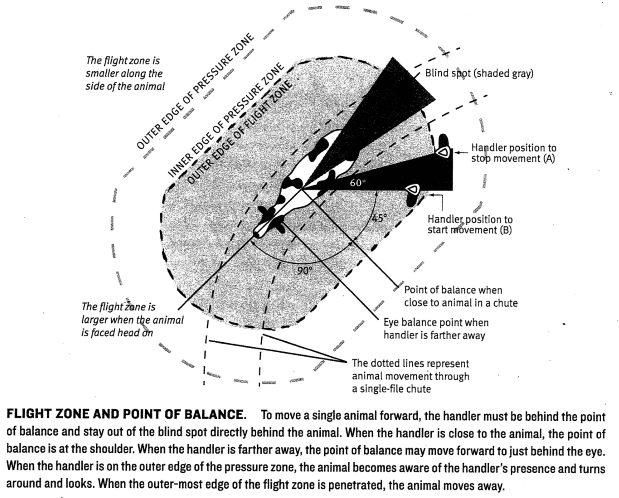
The edge of the flight zone can be determined by slowing walking up to the animals. The circle represents the edge of the flight zone (22).
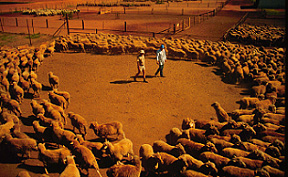
Extremely tame livestock are often difficult to drive because they no longer have a flight zone. These animals should be led with a feed bucket or halter. The size of the enclosure the livestock are confined in may affect flight zone size. Sheep experiments indicated that animals confined in a narrow alley had a smaller flight zone compared to animals confined in a wider alley (49). Approaching an animal head on will increase flight zone size (Bud Williams, personal communication).
When a person enters an animal's flight zone it will move away. If the handler penetrates the flight zone too deeply, the animal will either bolt and run away, or turn back and run past the person. When the flight zone of a group of bulls was invaded by a mechanical trolley, the bulls moved away and maintained a constant distance between themselves and the trolley (54). The best place for the person to work is on the edge of the flight zone (22). This will cause the animals to move away in an orderly manner. The animals will stop moving when the handler retreats from the flight zone. To make an animal move forward, the handler should stand in the shaded area marked in the flight zone diagram (22). To cause the animal to back up, the handler should stand in front of the point of balance (57). A flag on the end of a stick can be used to sort cattle by moving it back and forth across the point of balance (57).
Many people make the mistake of deeply invading the flight zone when cattle are being driven down an alley or into an enclosed area such as a crowd pen. If the handler deeply penetrates the flight zone, the cattle may turn back and run over him (3). If the cattle attempt to turn back, the person should back up and retreat from inside the flight zone. The reason why the livestock attempt to turn back is because they are trying to escape from the person who is deep inside their flight zone.
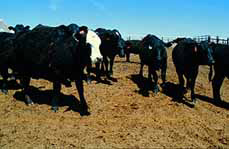 |
When the handler is outside the flight zone but had entered the zone of awareness (pressure zone) the animals will turn and face the handler and maintain a safe distance. When animals become accustomed to a calm handler and learn to trust the handler they will have less of a tendency to look at the handler. They will walk away straight without turning. The animals have learned that the calm handler will back up and remove pressure from the flight zone when they go where the handler wants them to. |
| When the handler enters the flight zone the animals will turn away. The approaching handler is outside the flight zone of the light colored animal that is still laying down. However, the handler has entered the zone of awareness of the light colored animal because it is looking at the handler. | 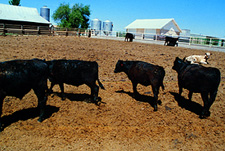 |
Cattle sometimes rear up and become agitated while waiting in a single file chute. A common cause of this problem is a person leaning over the chute and deeply penetrating the flight zone (25). The animal will usually settle back down if the person backs up and retreats from the flight zone. Inexperienced handlers sometimes make the mistake of attempting to push a rearing animal back down into a chute. The animal will often react to this by becoming increasingly agitated. Both the handler and the animal have a greater likelihood of being injured. This also explains why livestock will balk if they see people standing in front of the squeeze chute. The provision of shields for handlers to stand behind will improve animal movement (17, 54).
| Handler movement pattern to keep cattle moving into a squeeze chute or restrainter |
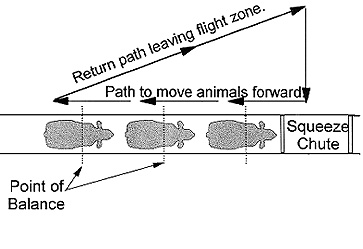 |
Click here to see a menu of video clips of cattle handling.
The most common mistake is attempting to push cattle or pigs with the crowd gate. The crowd gate on a tub should be left in the position shown in the diagram below. Most of the time, the cattle will easily enter the single file chute. The crowd gate is similar to the emergency brake in a car. The only time you may need to crowd an animal is when a single, lone, agitated animal is attempting to jump out. The diagram also shows the handler with a flag working the pivot point of the crowd gate. The cattle will easily circle around the handler. The tub is laid out in a full half circle to take advantage of the natural behavior of cattle to go back to where they came from. NEVER push a crowd gate up tight against the animals. Fill the crowd pen half full. Good handling will require more walking to move small groups. If animals balk and refuse to enter the single file, you may need to tie a back stop gate open.
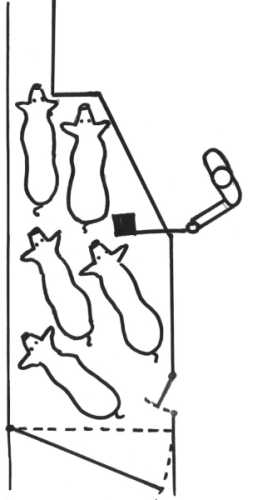 |
All types of livestock will move more easily when the hanlder works from the front. The offset step stops the pigs from jamming. For cattle, make one side straight and the other side on a 30 degree angle. The handler should work on the angled side. |
| Simple round tub where a handler who is working at the gate pivot point is using the natural behavior of cattle to circle around him. | 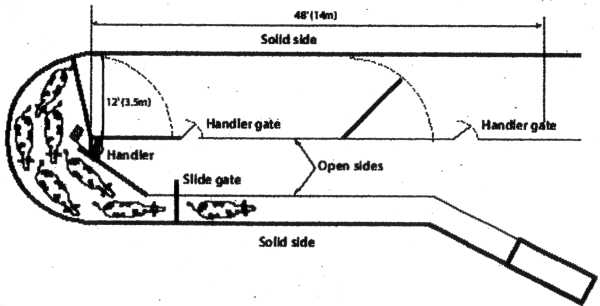 |
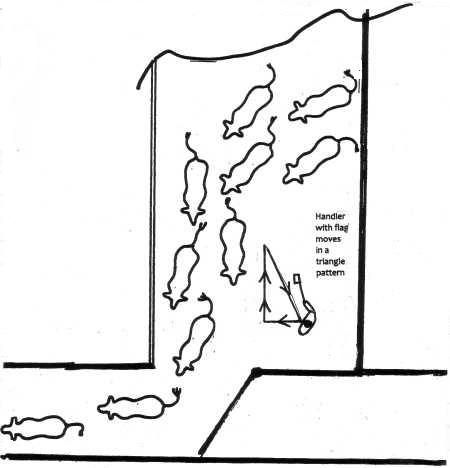 |
Diagram for moving cattle quietly out of a gate. The handler moves in a small triangle as shown on the diagram. Sometimes the handler barely has to move after the flow is started. A good way to visualize the movement is that after the flow through the gate has started, the cattle moved around the hanlder on the edge of a bubble that is like a "force field" around the handler. The cattle position themselves in a relation to the hanlder so they maintain a flight zone between themselves and the handler.. |
More information is available on cattle behavior in the 4th Edition of Livestock Handling and Transport published by CABI.
All livestock are herd animals, and they are likely to become highly agitated and stressed when they are separated from their herd mates. Physiological changes which occur during isolation may affect productivity or research results.
Isolation is a strong stresser. Restraint and isolation in a small box reduced immune response in pigs (65). In sheep and cattle isolation was highly stressful (15, 55, 80). A dairy cow left alone in a stanchion had increased leucocytes in her milk (62).
During handling, isolated large animals that become agitated and excited are likely to injure handlers. Many serious cattle handling accidents have been caused by isolated frantic cattle (Grandin, 1987). If an isolated animal becomes agitated, other animals should be put in with it.
Cattle and sheep are motivated to maintain visual contact with each other (14, 95). Animals will readily follow the leader. Skillful handlers allow livestock to follow the leader and do not rush them. If animals bunch up, handlers should concentrate on moving the leaders instead of pushing a group of animals from the rear. Trained sheep can be used to lead sheep through a handling facility (5). Groups of animals that have body contact remain calmer (15). A tame pacifier cow will keep a wild cow calm during artificial insemination. The wild cow will stand quietly while maintaining tactile contact with the tame cow (31). A loading ramp for pigs or sheep that has a "see through" center partition (31) takes advantage of natural following behavior. As the animals walk up the twin single file chutes, they can see each other through the center partition. Solid outer walls block outside distractions.
Highly excited Brahman cattle may lie down and become immobile if they are repeatedly prodded with an electric prod. Continuous electric prodding of Brahman or Brahman cross cattle can result in death (31). If the animal is left alone for a few minutes, it will usually get up. English or European cattle such as Charolais will seldom become immobile.
"...Brahman cattle are more excitable than the British breeds but when they are handled gently they can become extremely docile. Brahmans are inquisitive sensitive cattle that respond well to quiet gentle handling and they respond poorly and may become agitated if they are treated roughly. Since Brahman have a more reactive nervous system they may become easily frightened when subjected to sudden novel experiences. For example, going through an auction ring. Brahmans will often remain calm if they have a familiar person who can handle them when they are in a novel strange situation. British cattle on the other hand are less likely to become fearful or agitated when subjected to sudden novelty...."
Different breeds of sheep also react differently to handling (82, 95). Rambouillet tend to flock tightly together and remain in the group. Cheviots are more independent than other breeds.
More information is available on genetics and animal behavior in the 2nd Edition of Genetics and the Behavior of Domestic Animals.
The author has successfully achieved dominance over a group of pigs. Slapping the dominant pig when it bit the author had little effect on its behavior. The aggressive behavior was stopped by shoving the pig against the fence with a board pushed against its neck (31). The board against the neck simulated another pig pushing and biting. Pigs exert dominance over each other by biting and pushing against the neck (45). It is often advisable to handle the dominant pig first (P.Dziuk, 1983 personal communication). The odor of the dominant pig on the handler may make the other pigs more submissive. More research is needed to develop simple methods of exerting dominance which will enable handlers to control boars and other large animals with a minimum of force and greater safety.
Sheep raised in a pen in close contact with people had a less intense physiological response to handling than sheep raised on pasture (78). Hails (38) reported that calves lost less weight the second time they were transported. Hens which were not accustomed to being caught and handled had lowered egg production. Egg production, however, was not affected in hens accustomed to frequent handling (46). Piglets accustomed to repeated gentle handling by people approached a strange person readily at 24 months of age (42).
Loading pigs into a vehicle was more difficult when confinement reared pigs were handled. Pigs reared outdoors were easier to load (93).
Our experiments also illustrate the different effects of environmental stimulation under different conditions. In the first trial, environmental stimulation for pigs housed in a windowless building consisted of hanging rubber hoses and weekly petting. The stimulation made the animals easier to drive through a chute and less prodding was required (29, 31, 32). In the second trial, the animals were initially very tame and both the control and extra stimulation pens were washed twice weekly with a hose. There was a tendency for the controls to be easier to drive because the petted pigs approached people for petting. Frequent pen washing provided environmental stimulation and may have helped to calm the controls. Tame animals should be led with a feed bucket or lead rope.
Calves accustomed to regular gentle handling had fewer injuries during marketing because they were accustomed to handling (96). Excitable cattle had lower weight gains (64). Dogs can be highly aversive to sheep (55). The use of dogs in a confined space where animals are unable to move away should be avoided. Electric prods should be used sparingly on cattle and never used on breeding pigs (31). Additional gentle methods for moving livestock are reviewed in Kilgour and Dalton (57). Cattle will be easier to handle in the future if they are not allowed to rush out of corrals back to pasture. Cattle should become accustomed to walking slowly past a handler when they exit the corrals (Bud Williams, personal communication).
Cattle handled roughly in poorly designed facilities had higher heart rates compared to cattle handled calmly in well designed facilities (83). Chickens handled gently had lower plasma corticosterone levels compared to chickens handled roughly (8).
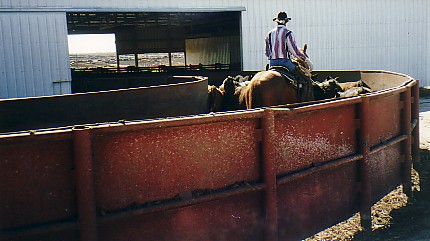
Cattle differentiate between a person on a horse and a person on the ground. Cattle that are always worked on horseback may panic if they are moved by a person on the ground. To prevent this problem it is recommended to get the animals accustomed to being moved by both people on the ground and people on horseback. They should also be trained to have different people and vehicles around them. This photo shows a well designed wide curved alley that leads up to a round crowd pen. The cattle enter easily because they can see light through the building.
It is very important that an animal's first experience with a new person, corral, or vehicle is a good one. If an animal's first experience with something new is bad the animal may develop a permanent fear memory. Animals are very specific in how they perceive events around them. A horse may become afraid of black cowboy hats while white cowboy hats will be tolerated. The fear of black cowboy hats was caused by severe abuse by a man wearing a black hat. Both pigs and cattle differentiate between people in alleys and people in their pens. To get animals accustomed to having people moving around them the people must enter the pens. Since animals do not have language, these memories will be in the form of pictures, sounds, or smells. Animals can instantly recognize the voice of a familiar trusted person. They may also become frightened when they hear the voice of a person who abused them. They also make associations such as people in blue coveralls are "safe" and people in white lab coats do painful procedures. Individual people that an animal associates with painful or frightening experiences may have difficulty training or working with an animal. The animal may be easier to train if a new person works with it.
This update is quoted from:
Grandin, T. 2014. Chapter 7: Handling Facilities and Restraint of extensively raised range cattle. In, T. Grandin (Editor), Livestock Handling and Transport. 4th Edition. CABI Publishing.
If a person shocked pigs every few days a chronic stress state was created (21). Inconsistent handling will cause stress. If a handler occasionally mistreats an animal, the animal is liable to be stressed every time the person approaches. An occasional aversive treatment lowered weight gain and increased corticosteroid levels even though the handler was gentle with the pigs most of the time (43). The pigs had learned that the handler could not be trusted.
Novelty can be a strong stressor. Animals that have been raised in a variable environment are less likely to be stressed when confronted with novelty. In one study veal calves were raised in indoor stalls or in outdoor group pens (R. Dantzer, personal communication, 1983). When the calves reached market weight, both groups were exposed to a new indoor and outdoor environment. Calves raised indoors had higher serum glucocorticoid values when they were put in an outdoor arena. Calves raised outdoors were more highly stressed when they were put in an indoor arena. Both of the new locations were stressful to all calves, but their reactions were influenced to the greatest extent by variance from the type of environment in which they had been reared. Animals can be trained to accept irregularity in management (78). Pigs exposed to a variety of objects approached a novel object more quickly than animals raised in a barren environment (32). However, pigs which had grown accustomed to the same routine of blood pressure testing, responded to a change in routine with increased blood pressure (67).
In our previously described handling experiment, the pigs initially became highly agitated during the novel experience of pen washing (32). When they become accustomed to pen washing they walked up to be sprayed. The experience of pen washing was initially stressful but it soon became a pleasant experience that the animals actively sought.
It is good for animals to have new experiences and novelty in their lives. Horses exposed to flags and many new things are less likely to panic at a horse show. Feedlot cattle that are exposed to some activity such as seeing people and vehicles often have better weight gains because they are less likely to become fearful if they are suddenly confronted with something new. At one feedlot, cattle in a pen next to the manager's house always had high weight gains. They could see children playing in the yard and they got accustomed to seeing many different vehicles. There is an optimum level of exposure to stimulation and too much would be stressful and probably lower weight gains. Continuous very loud noise or constant disturbances that continued all night would probably be stressful and lower weight gains.
The author has trained sheep to voluntarily enter a squeeze tilt table for a grain reward (33). Some sheep were squeezed and tilted to a horizontal position nine times in one day. After being released from the squeeze tilt table, the animals rapidly ran into the crowd pen and lined up in the chute (33).
To train the animals to voluntarily accept restraint, the restraint device must be introduced gradually and gently with feed rewards (33). At first, the animal is allowed to walk through the restrainer several times. The next step is to allow the animal to stand in the restrainer without being squeezed. On the fourth to fifth pass through, the squeeze is applied gently. During each step the animal is given a food reward of palatable feed. A relatively tame animal can be trained to voluntarily enter a restrainer in less than an hour.
Training animals to voluntarily enter a restraint device is easier and less stressful if the animal is tame and has little or no flight zone. If a wild animal is being trained, it is important to catch it correctly on the first attempt. Fumbling and failing to restrain an animal on the first attempt will result in increased excitement (15). If an animal resists and struggles, it must not be released until it stops struggling, otherwise it will be rewarded for resisting (29). Animals that are released while resisting are more likely to resist in the future (29). The animal should be stroked and talked to gently until it calms down.
Animals will not voluntarily accept restraint if the restraint device causes pain. Selection of the right type of squeeze chute and headgate to fit the specific handling requirements is important (23). The use of new designs for restraint devices should be investigated. Double rail and V restrainers that are used in meat packing plants may provide less stressful restraint for veterinary and husbandry procedures (18, 34, 81). Pigs will readily relax and fall asleep when restrained upright in a padded V restrainer. Pressure applied to the flanks will induce relaxation (37). Sheep and calves held on a double rail restrainer had low stress levels (94). The author has observed that cattle restrained with nose tongs become more difficult to restrain in the future. Further observations by the author indicated that when a halter is used to hold the animal's head for blood testing, restraining the head becomes easier with successive tests. Cattle blood-tested with halter head restraint will learn to turn their head and expose their jugular. Cattle that have had experience with nose tongs will often fling their head about to avoid attachment of the tongs.
People working with animals need to always be aware of individual differences between animals. Even in animals of the same breed, some will be more fearful than others. The Suffolk sheep described previously were easy to train in one day because Suffolks are calm animals. For most cattle the best way to train them is to work with them for about 15 minutes each day. This gives them time to calm down between handling and restraint training sessions. Cattle can be trained in 3 or 4 days, bison may require 3 weeks and antelope may take 3 months. Quiet breeds of cattle will quickly habituate to being driven through a race and restrained in a squeeze chute. For flightly antelope it takes 10 days to habituate them to the sound of a sliding door opening. New sights and sounds have to be introduced very gradually to avoid panic. This is the difference between a domestic and a wild animal. The extreme flighty temperament has been bred out of cattle.
For all species, solid sides are recommended on both the chute and the crowd pen which leads to a squeeze chute or leading ramp (7, 22, 24, 79). For operator safety, man-gates must be constructed so that people can escape charging cattle. The crowd gate should also be solid to prevent animals from turning back (31). Wild animals tend to be calmer in facilities with solid sides. In holding pens, solid pen gates along the main drive alley facilitate animal movement.
This made me think about how genetic differences in temperament could have an effect on handling yard and corral design. Many of the systems shown on www.grandin.com were orginally designed for much wilder cattle. High solid sides were needed when extensively raised flighty cattle were handled by people with minimal training in stockmanship. Today in many parts of the United States, beef cattle are genetically more docile compared to twenty years ago. This makes it easier to handle them in simpler facilities with open sides. Another factor is that ranchers today are learning better stockmanship. There are two approaches to handling facility and corral design. They are simpler facilities that require greater stockmanship skill or more elaborate facilities that require less stockmanship skills.
The author has observed other situations where genetics has had an effect on yard and corral design. Thirty years ago, when I visited a deer farm it was almost impossible to handle and restrain deer in outdoor corrals. They had to be handled in a dark room. In 2016, I observed docile deer at a New Zealand farm that could be easily handled in open corrals. A year later, I went to Brazil and observed differences in the behavior of a group of purebred Nelore cattle and a Nelore X Jersey cross. The crossbred animal had been raised in the same environment and it was obviously much calmer than the Nelores. To separate the genetic effects from the influence of previous handling experiences, the animals MUST ALL live in the same environment and be handled by the same people. Until now, I did not realize how much some groups of animals had changed. To see this, I had to observe both extremely flightly cattle and cattle with calm genetics being handled together. In both of these situations, the animals all had the same previous experiences.
Cattle and sheep crowd pens should have one straight fence, and the other fence should be on a 30 degree angle (66). This layout should not be used with pigs. They will jam at the chute entrance. Jamming is very stressful for pigs (90). A single, offset step equal to the width of one pig should be used to prevent jamming at the entrance of a single file ramp (24, 31). Jamming can be further prevented by installing an entrance restricter at single file race entrances. The entrance of the single file chute should provide only 1/2 cm on each side of each pig. More detailed information on facility layout can be found in Grandin (22, 24, 25, 28, 30).
 Click here for more information on the design of chutes, races, and crowd pens.
Click here for more information on the design of chutes, races, and crowd pens.
Ames, D.R. and L.A. Arehart. (1972). Physiological response of lambs to auditory stimuli. Journal of Animal Science. 34: 994-998.
Barber, A.A. (1981). Sheep yards. In: Proceedings of Sheep Wool Expo. South Australian Department of Agriculture. Pages: 32-48.
Blecha, F., S.L. Boyles. and J.G. Riley (1984). Shipping suppresses lymphocyte blastogenic responses in Angus and Brahman x Angus feeder calves. Journal of Animal Science. 59:576-583.
Bremner, K. and R. Kilgour (1980). Follow my leader: Techniques for training sheep New Zealand Journal of Agriculture. Pages: 25-29.
Broad, F. (1977). Sheep behaviour: Delivery systems Paper presented at Australian State Advisory Committee on Wool Harvesting. Australian Wool Corp.
Brockway, B. (1977). Planning a sheep handling unit. Farm Buildings Center, National Agricultural Center, Kenilworth, Warwickshire, England.
Broom, D.M., P.G. Knignt. and S.C. Stansfield (1986). Hen behavior and hypothalamic-pituitary-adrenal responses to handling and transport. Applied Behavioral Science. 16:98 (Abstract).
Burhenauer, D.B. and B. Fritsch (1980). Colour vision in domestic goats (capra hircus L.) Zeit Tierpsychol. 53: 225-230.
Darbrowska, B., W. Harmata. and Z. Lenkiewicz (1981). Colour perception in cows. Behaviour Processes. 6:1-10.
Dantzer, R. and P. Mormede (1983). Stress in farm animals: A need for re-evaluaton. Journal of Animal Science. 57:6-18.
Doney. J.M., R.G. Smith, and R.G. Gunn (1976). Effects of postmating environment stress on administration of ACTH on early embryonic loss in sheep. Journal of Agricultural Science. 87:133-136.
Douglas, A.G., M.D. Darre, and D. M. Kinsman (1984). Sight restriction as a means of reducing stress during slaughter Proceedings 30th European Meeting of Meat Research workers. Bristol, England. September 9-14. Pages: 10-11.
Ewbank, R. (1961). The behavior of cattle in crushes. Vet Record. 73:853.
Ewbank, R. (1968). The behavior of animals in restraint. In: M.W. Fox (Editor) Abnormal Behavior in Animals W.B. Saunders, Philadelphia. Pages: 159-178.
Falconer, I.R. and B.S. Hetzel (1964). Effect of emotional stress on TSH on thyroid vein hormone level in sheep with exteriorized thyroids Endocrinology. 75: 42-48.
Freeman, R.B. (1975). Functional planning of a shearing shed. Pastoral Review. 85:9-12.
Giger. W., R.P. Price, R. Westervelt, and D.M. Kinsman (1977). Equipment for low stress animal slaughter Trans. American Society of Agricultural Engineers. 20:571-578.
Gilbert, B J. and C.W. Arave (1986). Ability of cattle to distinguish among different wave lengths of light Journal of Dairy Science 69:825-832.
Galyean, M.L., R.W. Lee, and M.W. Hubbart (1981). Influence of fasting and transit on rumen and blood metabolites in beef steers. Journal of Animal Science. 53:7-18.
Gonyou, H. W., P. H. Hemsworth, and J. L. Barnett (1986). Effects of frequent interactions with humans on growing pigs Applied Animal Behavioural Science. 16:269-278.
Grandin. T. (1980a). Observations of cattle behavior applied to the design of cattle handling facilities. Applied Animal Ethology. 6:19-31.
Grandin. T. (1980b). Good cattle restraining equipment is essential. Veterinary Medicine & Small Animal Clinician. 75:1291-1296.
Grandin, T. (1982). Pig behavior studies applied to slaughter plant design. Applied Animal Ethology. 9:141-151.
Grandin, T. (1983a). Handling and processing feedlot cattle. In: G.B. Thompson and C.C. O'Mary (Editors) The Feedlot. Lea & Febiger. Philadelphia. Pages: 213-235.
Grandin, T. (1983b). Welfare requirements of handling facilities. In: S.H. Baxter, M.R. Baxter and J.A.C. McCormack (Editors) Farm Animal Housing and Welfare. Martinus Nijhoff. Boston. Pages: 137-149.
Grandin, T. (1984a). Reduce stress of handling to improve productivity of livestock. Veterinary Medicine. 79: 827-831.
Grandin, T. (1984b). Race system for cattle slaughter plants with 1.5m radius curves. Applied Animal Behaviour Science. 13:295-299.
Grandin, T. (1986a). Minimizing stress in pig handling Laboratory Animal. April 1986.
Grandin. T. (1986b). Livestock handling. Farm Buildings and Engineering. (23):17-19.
Grandin, T. (1987). Animal handling. In: E.O. Price (Editor). Veterinary Clinician of North America. 3:323-338.
Grandin, T. (1989a). Effect of rearing environment and environmental enrichment on behavior and neural development in young pigs. Doctoral Dissertation, University of Illinois.
Grandin, T. (1989b). Voluntary acceptance of restraint by sheep. Applied Animal Behavioral Science. 23:257-261.
Grandin, T. (1989c). Double rail restrainer for livestock handling. International Journal of Agricultural Engineers. 41:327-338.
Grandin. T., A.I. Taylor, and S. E. Curtis (1986a). Richness of pigs environment affects handling in chute. Journal of Animal Science. Suppl.1, 64:161.
Grandin. T., S.E. Curtis, T.M. Widowski, and J.C. Thurman (1986b). Electro-immobilization versus mechanical restraint in an avoid-avoid choice test. Journal of Animal Science. 62:1460-1480.
Grandin, T., N.Dodman, and L.Shuster (1989). Effect of Naltrexone on relaxation induced by flank pressure in pigs. Pharmacology Biochemistry and Behavior. 33:839-842.
Hails, M.R. (1978). Transport stress in animals: A review. Animal Regulation Studies. 1:289-343.
Hale, R.H., R.H. Friend, and A.S. Macaulay (1987). Effect of method of restraint of cattle on heart rate, cortisol and thyroid hormones. Journal of Animal Science. Suppl.1 (Abstract).
Hebel, R. and H.H. Sambraus (1976). Are domestic animals color blind? Berl Munch Tieratzi Wochenschr. 89(16):321-325.
Hemsworth, P.H., A. Brand and P.J. Willems (1981). The behavioral response of sows to the presence of human beings and its relation to productivity. Livestock Production Science. 8:67-74.
Hemsworth, P.H., J.L. Barnen, C. Hansen. and H.W. Gonyou (1986). The influence of early contact with humans on subsequent behavioral response of pigs to humans. Applied Animal Behavioral Science. 15:55-63.
Hemsworth, P.H., J.L. Barnett and C. Hansen (1987). The influence of inconsistent handling by humans on behaviour, growth and cortircosteroids of young pigs. Applied Behavioral Science. 17:245-252.
Hixon, D.L., D.K. Kesler, and T.R. Troxel (1981). Reproductive hormone secretions and first service conception rate subsequent to ovulation control with Synchromate. B Therio. 1,6:219-229.
Houpt, K.A. and T.R. Wolski (1982). Domestic Animal Behavior for Veterinarians and Animal Scientists. Ames, Iowa State University Press.
Hughes, B.O. and A.J. Black (1976). The influence of handling on the production, egg shell quality and avoidance behavior in hens. British Journal of Poultry Science. 17:135-144.
Hutson, G.D. (1980). The effect of previous experience on sheep movement through yards. Applied Animal Ethology. 6:233.
Hutson. G.D. (1981). Sheep movement on slotted floors. Australian Journal of Experimental Agriculture Husbandry. 21:474-479.
Hutson, G.D. (1982). Flight distance in Merino sheep. Animal Production. 35:231-235.
Hutson, G.D. (1985a). Sheep and cattle handling facilities. In: B.L. Moore and P.J. Chenoweth (Editors) Grazing Animal Welfare. Australian Veterinary Association, Queensland. Pages:124-136.
Hutson, G.D. (1985b). The influence of barley food rewards on sheep movement through a handling system. Applied Animal Behaviour Science. 14:263-273.
Jones, B.R. and J.M. Faure (1981). The effects of regular handling on fear responses in the domestic chick. Behavioural Processes. 6:135-143.
Kelley, K.W., C. Osborn, J. Evermann, S. Parish, and D. Hinrichs (1981). Whole blood leukocytes vs separated mononuclear cell blastogenesis in calves, time dependent changes after shipping. Canadian Journal Comp. Med. 45:249-258.
Kilgour, R. (1971). Animal handling in works, pertinent behaviour studies. 13th Meat Industry Research Conference, Hamilton, New Zealand. Pages:9-12.
Kilgour, R. and H. DeLangen (1970). Stress in sheep resulting from management practices. Proceedings New Zealand Society of Animal Production. 30:65-76.
Kilgour, R. (1983). Using operant test results for decisions on cattle welfare. Proceedings Conference on the Human Animal Bond. Minneapolis, Michigan. June 13 & 14, 1983.
Kilgour, R. and C. Dalton (1984). Livestock Behaviour, a Practical Guide. Westview Press, Boulder, Colorado.
Klopfer, F.D. and R.L. Butler (1964). Color vision in swine. American Zoology. 4:294.
Lemman, W.B. and G.H. Patterson (1964). Depth perception in sheep: Effects of interrupting the mother-neonate bond. Science. 145:835-836.
Lott, D.F. and B.L. Hart (1979). Applied ethology in a nomadic cattle culture Applied Animal Ethology. 5:309-319.
Luyerink, J.H. and J.P.W. van Baal (1969). Heart rate counting from photolethysmographic records as an aid in the search of better methods of handling hogs prior to slaughter. 15th European Meeting of Meat Research Workers. August 17-24. Helsinke, Finland.
Lynch, J.J. and G. Alexander (1973). The Pastoral Industries of Australia University Press, Sydney, Australia. Pages:371-400.
Marshal-Nimis, M. and W.M. Rempel (1986). Breed differences in pig behavior: Effects of lighting and loading methods. Proceedings Livestock Conservation Institute, South St. Paul, Michigan. Pages:44-46.
McGaugh, J.W. (1984). Disposition as it affects gain. Feedlot Research Briefs, Mooreman Mfg. Co. Quincy, Illinois.
Mertsching, H.J. and K.W. Kelley (1983). Restraint reduces size of thymus gland and PHA swelling in pigs. Journal of Animal Science. (Suppl.1) 57:175-176.
Meat and Livestock Commission Cattle handling Livestock Buildings Consultancy. Meat and Livestock Commission. Queensway, Bletchley, Milton Keynes, England (no date).
Miller, K.N. and S. Twohill (1983). A method for measuring systolic blood pressure in the conscious swine (Suss crofa). Lab Animal. 12(6):51-52.
Munkenbeck, N.W. (1982). Color vision in sheep. Journal of Animal Science. (Suppl.1) 55:129.
Panepinto. L.M., R.W. Phillips, S. Norden, P.C. Pryor, and R. Cox (1983). A comfortable minimum stress method of restraint for Yucatan miniature swine. Laboratory Animal Science. 33(1):95-97.
Parsons, R.A. and W.N. Helphinstine (1969). Rambo A.I. breeding chute for beef cattle. One-Sheet Answers, University of California, Agricultural Extension Service, Davis, California.
Pascoe, P.J. (1986). Humaneness of an electro-immobilization unit for cattle. American Journal of Veterinary Resource. 10:2252-2256.
Pearson, A.M., R. Kilgour, H. DeLangen, and E. Payne (1977). Hormonal responses of lambs to trucking, handling and electric stunning. Proceedings New Zealand Society of Animal Production. 37:243-248.
Peischel, A, R.R. Schalles, and C.E. Owenby (1980). Effect of stress on calves grazing Kansas Hills range. Journal of Animal Science. Suppl.1: 24 25.
Phillips, P.A., B.K. Thompson, and D. Fraser (1987). Ramp designs for young pigs. Technical Paper No. 87-4511. American Society of Agricultural Engineers. St. Joseph, Michigan.
Prince, J.H. (1977). The eye and vision In: M.J. Swenson (Editor). Dukes Physiology of Domestic Animals. Cornell University Press, New York. Pages:696-712.
Pumprey, J. (1986). The Nobel Foundation Ardmore, Oklahoma, Personal Communication
Ray, D.E., W.J. Hansen, B. Theurer, and G.H. Stott (1972). Physical stress and corticoid levels in steers. Proceedings Western Section of American Society of Animal Scientists. 23:255-259.
Reid, R.L. and S.C. Mills (1962). Studies of the carbohydrate metabolism of sheep. XVI. The adrenal response to physiological stress. Australian Journal of Agriculture. Resource 13:282-294.
Rider, A., A.F. Butchbaker, and S. Harp (1974). Beef working, sorting and breeding facilities Technical Paper No. 74-4523. American Society Agricultural Engineers. St. Joseph, Michigan.
Rushen, J. (1986). Aversion of sheep for handling treatments paired choice studies. Applied Animal Behavioral Science. 16:363-370.
Schmidt, C.O. (1972). Cattle handling apparatus. U.S. Patent No.3,657,767, Washington, DC.
Shupe, W.L. (1978). Transporting sheep to pastures and markets. Technical Paper No. 78-6008. ASAE St. Joseph, Michigan.
Stermer, R. A., T.H. Camp, and D.G. Stevens (1981). Feeder cattle stress during handling and transportation American Society of Agricultural Engineers. Technical Paper No. 81-6001. St. Joseph, Michigan.
Stoebel, D.P. and G.P. Moberg (1982). Repeated acute stress during follicular phase and luteinizing hormone surge in dairy heifers. Journal of Dairy Science. 65:92-96.
Stott, G.H., F. Wiersma, and V. Vaz (1975). Embryonic mortality. Western Dairy Journal. April 1975. Pages:26-27.
Swan, R.(1975). About A.I. Facilities. New Mexico Stockman. February 11. Pages:24-25.
Syme, L.A. and G.R. Elphick (1982/83). Heart rate and the behaviour of sheep in yards. Applied Animal Ethology. 9:31-35.
Thines, G. and M. Soffie (1977). Preliminary experiments on colour vision in rams. British Veterinary Journal. 133:97-98.
Tulloh, N.M. (1961). Behaviour of cattle in yards: II. A study of temperament. Animal Behavior. 9:25-30.
van Putten, G. and W.J. Elshoff (1978). Observations on the effect of transport and slaughter on the well-being and lean quality of pigs. Animal Regulation Studies. 1:247-271.
van Putten, G. (1981). Handling slaughter pigs prior to loading and unloading on a lorry Paper presented at the seminar 'transport.' C.E.C., Brussels, July 7-8, 1981.
Vowles, W.J., G. and T.J. Hollier (1982). The influence of yard design on the movement of animals. Proceedings from the Australian Society of Animal Production. 14:597.
Warriss.,P.D., S.C. Kestin, and J.M. Robinson (1983). A note on the influence of rearing environment on meat quality in pigs. Meat Science 9:179-271.
Westervelt, R.G., D.M., Kinsman, R. Prince, and W. Giger (1976). Physiological stress measurement during slaughter of calves and lambs Journal of Animal Science. 42:831-834.
Whatley, J., R. Kilgour, and D.C. Dalton (1974). Behaviour of hill country sheep breeds during farming routines New Zealand Society of Animal Production. 34:28.
Wythes, J.R. and W.R. Shorthose (1984). Marketing cattle: Its effect on live weight carcass and meat quality. Australian Meat Research Committee Review No.46 A.M.R.C. Sydney, Australia.
Jacobs, G.H., 1998. Deegan, J.F., and Neitz, J. Photopigment basis for dichromatic color vision in cows, goats, and sheep. Visual Neur. Sci. 15:581-584.
LeDoux, J. 1996. The Emotional Brain. Simon and Schuster, New York.
Miller, P.E., and C.J. Murphy. 1995. Vision in dogs. J. Amer. Vet. Med. Assoc. 12:1623-1634.
Pick, D.F., G. Lovell, S. Brown, and D. Dail. 1994. Equine color perception revisited. Appl. Anim. Behav. Sci., 42:61-65.
Talling, J.C., N.K. Waran, C.M. Wathes, and J.A. Lines. 1998. Sound avoidance by domestic pigs depends upon characteristics of the signal. Appl. Anim. Behav. Sci., 58:(3-4)255-266.
Talling, J.C., N.K. Waran, and C.M. Wathes. 1996. Behavioural and physiological responses of pigs to sound. Appl. Anim. Behav. Sci., 48:187-202.
Smith, B. 1998. Moving 'em: A guide to low stress animal handling. University of Hawaii. Graziers Hui, Kamuela, HI.
Waynert, D.F., J.M. Stookey, K.S. Schwartzkopf-Genwein, J.M. Watts, C.S. and C.S. Waltz. 1999. Response of beef cattle to noise during handling. Appl. Anim. Sci. (In Press).
Grandin, T., Rooney, M.B., Phillips, M., Irlbeck, N.A., and Grafham, W. 1995. Conditioning nyala (Tragalaphus angasi antelope) to blood sampling in a crate using positive reinforcement. Zoo Biology, 14:261-273.
Grandin, T. 1998. Handling methods and facilities to reduce stress on cattle. Veterinary Clinics of North America, 14:325-341.
Smith, B. 1998. Moving 'Em: A Guide to Low Stress Cattle Handling. Graziers Hui Kamuela, Hawaii. Available from Grass Farmer, P.O. Box 2300, Ridgeland, Mississippi, 39158-2300, USA.
Grandin, T. (Editor). 2010. Improving Animal Welfare: A Practical Approach. CABI Publishing, Wallingford, Oxfordshire, United Kingdom. (Now has 2015 2nd Edition)
Cooke, R.F., Arthington, J.D., Araujo, D.B., and Lewis, G.C. (2009). Effects of acclimation to human interaction on performance, temperament, physiological responses, and pregnancy rates in Brahman crossbred cows. Journal of Animal Science. 87:4125ó4132.
Grandin, T. 2014. Livestock Handling and Transport, 4th Edition. CABI Publishing, Wallingford, Oxfordshire, UK.
Grandin, T. and Deesing, M.J. (Editors). Genetics and the Behavior of Domestic Animals, 2nd Edition. Academic Press Elsevier, San Diego, CA, USA.
Koba, Y., and Tanida, H. (1999). How do miniature pigs discriminate between people? The effect of exchanging cues between a non-handler and their familiar handler on discrimination. Applied Animal Behaviour. 61:239-252.
Leiner, L. and Fendt, M. (2011). Behavioral fear and heartrate responses in horses after exposure to novel objects: Effects of habituation. Applied Animal Behaviour Science. 131:104-109.
Mateo, J.M., Estep, D.Q., and McMann, J.S. (1991). Effects of differential handling on the behaviour of domestic ewes. Applied Animal Behaviour Science, 32:45-54.
Grandin, T. and Shively, C. (2015). How farm animals react and perceive stressful situations such as handling restraint and transport. Animals. 5(4):1233-1251 (open access).
Ceacero, F. et al (2014). Habituating to handling: Factors affecting preorbital gland opening in Red Deer calves. Journal of Animal Science. 92:4130-4136.
Rault, J.L, et al (2011). Separation distress in artificially reared lambs depends on human presence and number of conspecifies. Applied Animal Behavior Science. 132:42-50.
Shinozaki, A. et al (2010). Tography of ganglion cells in the photorecptors in the sheep retina. Journal of Comparative Neurology. 518:2305-2315.
Stockman, C.A. et al (2011). Qualitative behavioral assessment and quantitative physiological measurement of cattle niave and habituated to road transport. Animal Production Science. 51:240-249.
Vetters, M.D.D. et al (2013). Comparison of flight speed and exit score as measurements of temperament on beef cattle. Journal of Animal Science. 91:374-381.
Wickham, S.L. et al (2015). Qualitative behavioral assessment of transport niave and transport habituated sheep. Journal of Animal Science. 90:4523-4535.
Waiblinger, S. et al (2012). The relationships between attitudes and personal characteristics and behvior of stock people and subsequent behavior and production of dairy cows. Applied Animal Behavior Science. 79:195-219.
 Click here to return to the Homepage for more information on animal behavior, welfare, and care.
Click here to return to the Homepage for more information on animal behavior, welfare, and care.